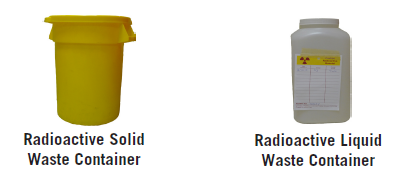The University of Toronto is committed to ensuring that the use of radioactive materials and radiation devices is carried out in a safe manner with due regard for employees, students, the public and the environment. The Radiation Protection Program, X-ray Safety Program and Laser Safety Program were developed to ensure the University's compliance with Canadian Nuclear Safety Commission (CNSC) regulations and other applicable legislation. These programs describe the permitting, procedural and training requirements which apply to the use of radioisotopes, X-ray devices and lasers at the University.
Radiation Protection Services (RPS) under the Office of Environmental Health & Safety administers these programs by providing expertise in matters pertaining to facility and equipment design; work practices and procedures; permitting / registration of radioactive materials and radiation devices; and training and authorization to lab users. RPS also executes the mandate of the University of Toronto Radiation Protection Authority (UTRPA), which governs all aspects of radiation safety at U of T and whose membership consists of senior academics and administrative staff members. In addition, the U of T Laser Safety Committee establishes and maintains standards and guidelines for the safe use of lasers.
As Low As Reasonably Achievable (ALARA)
The ALARA principle is the UTRPA's basic philosophy governing the use of radioactive materials at the University. The ALARA principle strives to keep all doses of radiation to lab personnel as low as reasonably achievable, while taking social and economic factors into consideration. No practice involving exposure to ionizing radiation may occur if there is no benefit as a result of carrying out the practice. Radiation exposures must be kept below the statutory federal limit, regardless of the practice.
There are 3 main strategies for mitigating radiation exposure:
- Time - limit the amount of time spent in the radiation field
- Distance - increase your distance from the radiation source
- Shielding - select the appropriate shielding material specific to the type of radiation emissions
Permits
You are required to obtain a permit through RPS if you are working with the following (click on the links below for more information):
- Radioisotopes (open and sealed sources): typical examples include H-3, C-14, P-32, P-33, S-35, Ca-45, Cr-51, Fe-59, Ni-63, I-125
- Irradiators
- Radiography equipment
- X-ray sources and devices
- Class 3B and 4 lasers as defined by the ANSI Z136.1 - Safe Use of Lasers standard
Depending on the type of permit issued, permit holders and authorized users have various responsibilities which may include:
- Registering radiation devices and equipment before use
- Utilizing appropriate controls (e.g. shielding) and personal protective equipment for the work
- Participating in a dosimetry or medical surveillance program, e.g. whole body / ring TLD, thyroid bioassay monitoring, eye examinations
- Conducting direct or indirect contamination monitoring, i.e. Geiger-Müller survey meter, liquid scintillation counter
- Decontaminating or decommissioning the work area when required
- Reporting all abnormal incidents involving radiation or radioactive material to RPS
- Keeping all radiation exposure and associated risk As Low As Reasonably Achievable
Radioisotope Lab Procedures
All radioisotope orders are tracked and approved by RPS. You must place your radioisotope order through uSOURCE (preferred) or the Financial Information System (FIS), and supply the required information (permit number, isotope, number of vials, etc.) with each order submission.
U of T permit holders may request a radioisotope transfer between labs by notifying RPS via email. For transferring radioactive materials outside of the University, you must complete the Transfer of Radioactive Material (Off Campus) form.
The UTRPA requires that each permit holder maintain an accurate, current inventory of all radioactive materials in their possession. Records must be available for inspection by RPS or the CNSC at all times. For sealed sources, the inventory is generally included on the radioisotope permit itself, whereas for open sources, all radioisotope shipments, usage and disposal must be tracked via an online database.
All radioactive materials must be disposed of as hazardous waste. Waste should be properly segregated into 3 streams: solid waste (contaminated gloves, paper), liquid waste (disposed according to half life) and special cases (liquid scintillation vials and radioactive sharps waste). Radioactive waste should be placed in the appropriate containers obtained from Central Stores and disposed of in radioactive waste storage room SW101, using UTSC Disposal Procedures for Radioactive Waste.

Training
EHS provides in-class and online training courses on radiation, X-ray and laser safety.
Resources
For additional information about radiation safety, please see the RPS website or contact RPS directly.